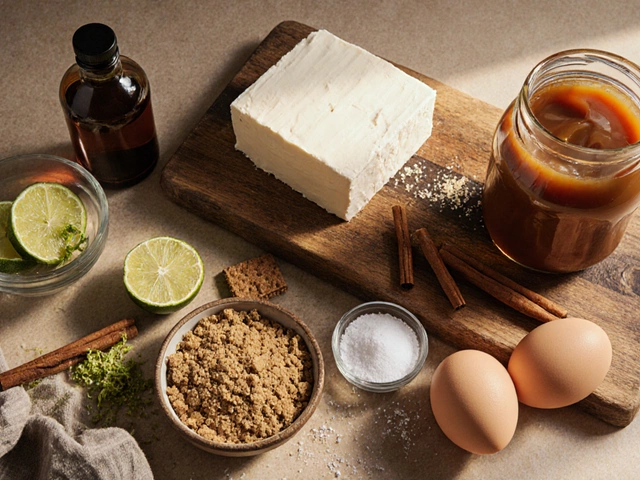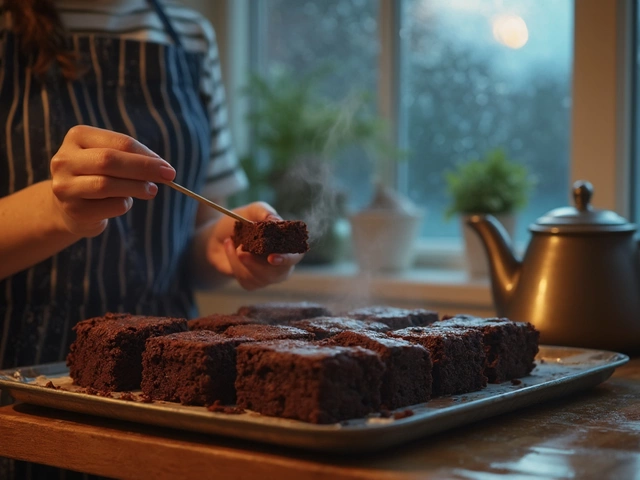
You'd think a candy bar or gummy bear would be safe, but a surprising amount of sweet stuff hides animal ingredients. Seriously—gelatin, honey, milk powder, even red food coloring can trip you up. That doesn't mean you have to give up dessert altogether. You just need to know what to check for and where to look.
Plenty of popular sweets are accidentally vegan, so you don't even have to fork out for specialty brands. Oreos? They're a go. Swedish Fish? Yep, most versions are totally fine. But not all candies are created equal, so getting familiar with ingredient lists saves you time and disappointment. If you’ve ever stood in an aisle squinting at tiny print, you know the struggle is real.
The cool part is, lots of brands now slap a 'vegan' label right on the package. That makes things so much easier, especially when you're craving something right now and don’t feel like translating science terms into English. But don’t worry, you’ve got options—from on-the-go gummies to homemade brownies. Dessert is still on the menu.
- Sneaky Ingredients to Watch For
- Popular Store-Bought Vegan Sweets
- Easy Homemade Vegan Dessert Ideas
- How to Read Labels Like a Pro
- Vegan Alternatives for Classic Treats
- Tips for Satisfying Your Sweet Tooth
Sneaky Ingredients to Watch For
If you’re thinking all candy without meat is safe, think again. Tons of vegan sweets out there actually sneak in animal products where you least expect them. The ingredient lists can seriously catch you off guard if you're not careful.
Gelatin is one of the main culprits. It’s made from animal bones and is found in most chewy candies and marshmallows. Red candies sometimes get their color from carmine (also called cochineal), which is literally made from crushed bugs. It sounds wild, but it’s super common.
Here’s a quick list of animal-based ingredients to watch for when you’re eyeing up vegan desserts and plant-based candy:
- Gelatin: usually in gummies, marshmallows, and some frosting
- Carmine (or cochineal): a red dye in gummies, icing, and hard candy
- Shellac: gives that shiny coating, especially on jellybeans and coated chocolate
- Honey: sometimes in nougat, granola treats, or chocolate bars
- Milk and whey: used in chocolate, caramel, and baked goods
- Lactose: often in protein bars and even in some mints
- Egg whites (albumen): hiding in nougat, meringue, or old-school treats
It can be annoying, but checking labels is a must since companies change recipes all the time. The same brand of dark chocolate can be vegan one year and swap in milk fat the next.
| Ingredient | Common Products | Animal Source? |
|---|---|---|
| Gelatin | Gummies, marshmallows | Yes |
| Carmine | Red candy, sprinkles | Yes (from insects) |
| Honey | Granola bars, chocolate | Yes |
| Shellac | Jellybeans, candy coating | Yes (from bugs) |
| Whey/Milk | Chocolate, baked goods | Yes |
Accidentally eating something non-vegan is super common. Even experts say so:
“It’s easy to assume candy is vegan, but even experienced vegans get tripped up by hidden animal-derived ingredients. Always double-check labels, especially if the packaging changes.” — The Vegan Society
To play it safe, look for the word "vegan" on the package, and if it’s missing, scan the ingredients for these sneaky culprits.
Popular Store-Bought Vegan Sweets
If you’re ever caught in a snack attack and need a sugar fix fast, you’ll be happy to know that a bunch of vegan sweets are waiting for you at most stores. Some you might know already; others are hiding in plain sight, just without an obvious “vegan” label. Here’s the scoop.
First up: the classics that don’t need animal ingredients to taste amazing. Oreos are basically every vegan’s lifeline during a craving—they’re accidentally vegan, and the original flavor works great if you avoid any limited editions with odd fillings. Then there’s Swedish Fish and Sour Patch Kids—yep, the regular versions have no gelatin, making them solid choices.
Let’s name-drop some more brands so you can walk into a shop and know what to grab:
- Skittles—Gelatin-free and zero animal products in US and UK versions since 2010. Just avoid the yogurt-dipped options.
- Twizzlers—These cherry twists are gelatin-free, so no worries there.
- Biscoff Lotus Cookies—The crunchy European cookie that’s vegan and perfect with coffee, tea, or by the handful.
- Justin’s Dark Chocolate Peanut Butter Cups—Check for “vegan” label; only the dark chocolate is safe.
- Tate’s Bake Shop Vegan Cookies—Yes, they make a real vegan line now. Good luck not eating the whole bag.
- Dandies Marshmallows—Perfect if you miss s'mores—no gelatin, all fun.
Wondering how much choice you actually have now? Check out this quick snapshot:
| Candy Brand | Confirmed Vegan | Main Animal Ingredients to Avoid in Non-Vegan Versions |
|---|---|---|
| Oreos | Yes (original & many flavors) | Milk (in non-standard, limited editions) |
| Swedish Fish | Yes (certain regions) | Gelatin, Beeswax (in some non-US/UK types) |
| Skittles | Yes | Carmine, Gelatin (older/limited flavors) |
| Biscoff | Yes | Milk (rare, special flavors) |
One tip: always double-check the label anyway—brands sometimes tinker with recipes. When in doubt, the plant-based candy section at places like Whole Foods, Target, or even CVS has grown a lot recently. You can now find everything from cream-filled wafers to chewy caramels that are fully dairy-free treats—and they taste like the real deal.
Easy Homemade Vegan Dessert Ideas
Making your own vegan desserts at home is way easier than it sounds, and you usually don’t need any weird ingredients. Most recipes just swap out eggs and dairy for simple plant-based options like almond milk, coconut oil, or mashed bananas. And you know exactly what goes into your treats, so you don’t have to second-guess ingredient lists.
A classic option is banana ice cream—literally just frozen bananas blended until creamy. Add a splash of vanilla, a handful of chocolate chips, or a spoonful of peanut butter to switch up the flavor. Need something chocolatey? Melt some dairy-free chocolate, mix with coconut milk, and pour it into ice cube trays for easy vegan fudge.
No-bake oat cookies are lifesavers on hot days. Just mash ripe banana, add oats, a bit of maple syrup, and toss in raisins or chopped nuts. Bake for 10 minutes, let cool, and you've got chewy, satisfying snacks without any animal products.
Want more ideas? Here’s a list of crowd-pleasers:
- Chia pudding – Mix chia seeds with plant milk and sweetener, let sit overnight. Top with berries.
- Fruit crumble – Toss fresh fruit with sugar, cover with a mix of oats, flour, brown sugar, and coconut oil, bake until golden.
- Vegan brownies – Use applesauce or flaxseed as an egg replacer. Most box mixes can be easily made vegan this way.
- Date energy balls – Blend pitted dates, cocoa powder, and nuts. Roll into balls and chill.
If you’re into numbers, the average vegan brownie recipe saves about 200mg of cholesterol per batch compared to a non-vegan version, since there’s no egg or butter. That’s a win for your heart and your sweet tooth.
So, most of these options come together in under 20 minutes, not counting chill time. You'd be surprised how fast you can whip up totally legit vegan sweets without spending all day in the kitchen.

How to Read Labels Like a Pro
If you want to keep your vegan sweets truly plant-based, the ingredient list is your friend—if you know what to look for. It's not always obvious though. Companies like to use science-y words or hide animal stuff in small print. So, let's break down how to do this quickly and painlessly.
First up, always check the 'Contains' statement under the ingredients. If it says milk, eggs, or honey, put it right back. But don't stop there. Some sneaky animal ingredients fly under the radar. Here's a list of common ones that often pop up in treats:
- Gelatin (made from animal bones and skin; usually in chewy candies and some marshmallows)
- Carmine (also called E120, a red dye made from beetles—used in some red or pink sweets)
- Lac or shellac (bug secretions used for shiny candy coatings)
- Casein, whey, lactose (all dairy derivatives)
- Confectioner's glaze (another bug-based coating, often in hard candies)
Sugar can be a gray area, since some refined sugars get filtered with bone char (yep, actual animal bones). In the US, bigger companies are starting to shift away from bone char, but if you want to play it safe, pick products labeled 'organic sugar'—that’s always bone char-free.
Pro tip: When you see a vegan or plant-based logo on sweets (they’re usually green), you can breathe easy. These products are third-party checked, so no animal ingredients are hiding inside.
Some brands are famous for being allergy-friendly and vegan, like Enjoy Life or YumEarth. Since these make it really clear on the front of the pack, you’ll spend less time analyzing labels.
| Label Term | What It Really Means for Vegans |
|---|---|
| May contain traces of milk/egg | Facility warning, not in the recipe (safe for most vegans) |
| Vegetarian | No meat but might contain dairy/eggs—keep checking |
| Natural flavors | Honestly, could go either way; check brand website or email them if in doubt |
The more products you check, the easier it gets. Eventually, you’ll spot a non-vegan ingredient at a glance. And if you're ever unsure, a quick Google or peek at the brand’s FAQ saves you from guessing in the aisle.
Vegan Alternatives for Classic Treats
Craving brownies or chocolate chip cookies but want to keep it vegan? No problem. Just about every classic dessert has a vegan cousin that doesn’t taste like a compromise. Vegan desserts are all about smart swaps rather than giving things up.
Milk and eggs are easy to dodge. For milk, grab any plant-based option—oat, soy, almond, or coconut all work in most recipes. Instead of eggs, try flaxseeds or chia seeds mixed with water, applesauce, or mashed bananas. They help bind baked goods without messing up the taste.
Here’s how you can flip your favorites into vegan sweets:
- Cookies & Brownies: Use vegan butter or coconut oil, plant milk, and egg replacers like flax 'eggs' or aquafaba (the liquid from canned chickpeas).
- Cakes: Skip the eggs, go for vinegar and baking soda for fluff, and swap dairy milk for oat or soy. Plenty of boxed mixes are already dairy-free, just check the label.
- Ice Cream: Tons of brands make non-dairy versions, usually using coconut, almond, or oat milk. Or blend frozen bananas at home for a simple fix.
- Chocolate: Lots of dark chocolate is accidentally vegan—just avoid anything with milk fat or lactose. Many brands now have “vegan” stamped right on them for peace of mind.
- Gummies & Marshmallows: Regular ones use gelatin, but vegan versions swap that for agar-agar or pectin. Brands like Dandies or YumEarth are solid options.
Curious how these swaps stack up? Check out this quick breakdown of some top substitutes—super helpful if you're new to baking vegan:
| Classic Ingredient | Vegan Swap | Common Use |
|---|---|---|
| Eggs | Flaxseed + Water (1 tbsp + 3 tbsp) | Brownies, Cookies |
| Milk | Oat or Almond Milk | Cakes, Pancakes |
| Butter | Vegan Margarine, Coconut Oil | Baking, Frosting |
| Gelatin | Agar-Agar, Pectin | Jellies, Marshmallows |
There are even vegan options for caramel, cheesecake, and fudge—no cow’s milk required. Some coffee shops now offer vegan donuts and pastries, so you don’t have to bake everything at home or feel left out when everyone’s snacking. The point: when you’re craving plant-based candy or any treat, there’s always a way to make it work. Just keep an eye out for sneaky ingredients like whey, honey, or confectioner’s glaze, and you’ll be eating dessert in no time.
Tips for Satisfying Your Sweet Tooth
Going vegan doesn’t mean your dessert game has to be boring or complicated. There are loads of ways to enjoy vegan sweets and keep cravings in check—without hunting for rare ingredients or spending all day in the kitchen.
- If you want candy, reach for brands you trust. Sour Patch Kids, Skittles, and Airheads in the US don’t use gelatin or dairy. Double-check the package, though, because recipes sometimes change by region.
- Plant-based candy is easier to find than ever. Even mainstream grocery stores often have a "vegan" section with everything from cookies to marshmallows. Trader Joe’s and Aldi usually have options if you’re in the States.
- Shop smarter by searching for products labeled as “dairy-free,” “egg-free,” or “vegan.” It’s not uncommon to spot mainstream treats like Lotus Biscoff and Enjoy Life chocolate chips right next to regular ones.
- Love to bake? Sub applesauce, flax "eggs," or mashed bananas for eggs. Plant milks like oat or almond work in place of cow’s milk with basically no taste trade-off. There are loads of recipes online for vegan desserts like brownies and cookies—and honestly, nobody will know the difference.
- Frozen treats aren’t off-limits. Ben & Jerry’s, So Delicious, and Halo Top all make vegan ice creams. Just check for that little "non-dairy" label.
Craving chocolate? Dark chocolate over 70% cocoa is usually vegan. Just watch out for sneaky milk fat or butter oil in the ingredients.
If you’re a fruit fan, nothing beats fresh berries with a splash of coconut whipped cream for a quick and sweet fix. Plus, it’s hard to feel guilty about dessert when most of it is fruit.
| Treat | Vegan-Friendly? |
|---|---|
| Swedish Fish | Yes (U.S. variety) |
| KitKat (classic) | No (contains milk) |
| Oreos | Yes (dairy-free) |
| Ben & Jerry’s Non-Dairy | Yes |
| Milk Chocolate | No (look for "vegan" versions) |
Last tip: Stock up on a few easy go-tos. Keep some dark chocolate, vegan marshmallows, or pre-made cookie dough on hand. You’ll never have to skip dessert—or feel like you’re missing out.












Write a comment